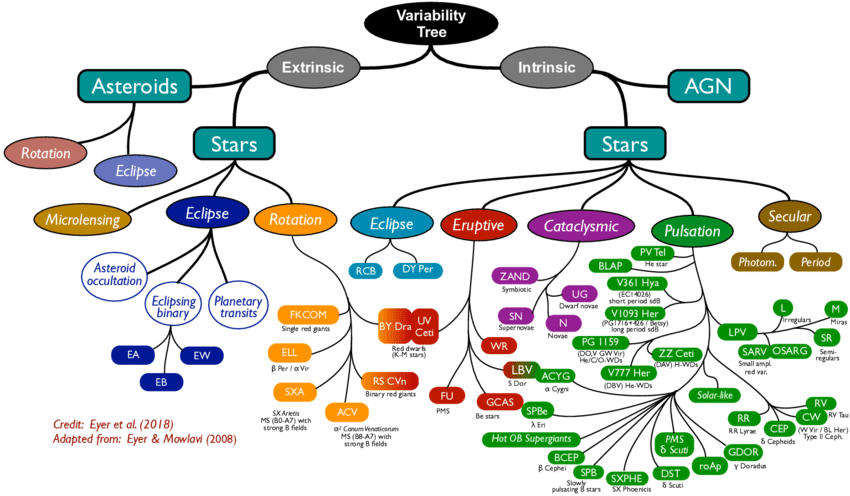Variability Tree
The diagram shown here is called the variability tree. It is useful for seeing the many different types of variables and their relationship to each other in one diagram. We explain it in words below.

The variability tree is presented upside-down, with the trunk at the top, and the branches extending downward. At the top it says only "variability tree"; this is the trunk. The first division going downward distinguishes extrinsic variables (on the left) and intrinsic variables (on the right).
Extrinsic Variability
Extrinsic variability is really only apparent variability, meaning that the object itself is not getting brighter or fainter overall, but its brightness appears to be changing because the object's orientation to us is changing, or some other object is intervening along our line of sight to the object.
The main branches of extrinsic stellar variables are stars and asteroids. Both can vary because of rotation or eclipses. Stars can also vary due to microlensing.
For stars, most extrinsic variability is due to occultation, when some or all of the star's light is blocked from reaching us. This occurs most commonly in eclipsing binary star systems. If the orientation of the binary orbit is edge-on to us, then the stars will take turns moving in front of each other, causing apparent changes in brightness called eclipses. If the two stars are very close together, their outer layers may be distorted by their mutual gravitational pull, changing the shape of the eclipse in the light curve. A similar, but much smaller change in brightness occurs when a planet moves in its orbit around a star and blocks a small fraction of the starlight from reaching us. This is called a planetary transit.
Many stars have surface irregularities called star spots, caused by strong magnetic field lines piercing the stellar atmosphere. Spots are usually cooler and dimmer regions on the surface. All stars rotate, so that the star spots move across our line of sight and then around to the far side of the star, and then back again. This is how rotation causes extrinsic variability.
Rotation or eclipses can also cause extrinsic variability for non-stellar objects like asteroids in our solar system.
One very rare kind of extrinsic variability -- microlensing -- causes a temporary brightening of a star. If a massive object like a star or a black hole passes in front of a luminous background star, the gravity of the intervening object will bend the light rays, focusing more of the light in our direction, like a lens. Gravitational microlensing can be recognized because it causes a characteristic cusp-shaped brightening of the light curve and occurs only once.
Intrinsic Variability
Intrinsic variability is caused by genuine changes in luminosity of the object being observed.
The main branches of intrinsic variables include stars and active galactic nuclei, or AGN. Stars can vary due to pulsation, cataclysmic, eruptive, eclipsing and secular changes.
True changes in the total luminosity of an object will happen if it changes size and/or temperature. Pulsating stars actually get larger and smaller. When they expand, the emitting surface grows and they become brighter; when they shrink again, they become dimmer. The pulsations of the outer layers of such variable stars are usually caused by changes in the opacity (the light-absorbing capability) of material in these layers, an effect called the kappa mechanism. For instance, as a pulsating star grows in size, its outer layer cool off, allowing electrons to recombine with atoms. The atoms then absorb less of the outward radiation pressure from the star, and begin to fall back in towards the center of the star, causing it to shrink. However, as those outer layers fall back in, they become denser, and so absorb more radiation, heating up. The heating reionizes the atoms (i.e., strips them of their outer electrons), so that they now absorb more radiation pressure, and are again driven outward. Thus, the star shrinks and grows, causing variability that repeats cyclically over a period of time, called periodic variability.
Cataclysmic variables do not pulsate. Instead, they show powerful explosions. They are usually binary systems with a very dense compact star, left over from the core of a now-dead star, in close orbit with a dwarf or giant star. The intense gravity of the compact star shears material away from the surface of its neighbor star. That material then swirls towards the compact star, forming an accretion disk of material that heats up as it approaches the dense compact star. If enough of that material builds up on the compact star, the high temperatures and densities there can reignite nuclear fusion on the stellar surface, causing a massive eruption and brightening called a nova. If the explosion is powerful enough it may destroy the star. Some types of supernova, also typed as cataclysmic, can occur in a single very massive star, when its core stops producing enough radiation energy to hold up its outer layers.
Another type of intrinsic variability is called eruptive. Some stars with very strong magnetic fields can unleash massive flares from their surfaces, causing a brief but intense increase in their luminosity.
Some cool giant stars can actually eclipse themselves, in a sense. They may sometimes expand and cool, producing large, opaque dust clouds that shroud their optical light, causing strong dimming events.
Stars evolve and change naturally as the composition and density of their core changes, eventually affecting the outer layers as well. Usually this secular evolution takes mlilions or billions of years, but some of the most rapid type of secular evolutipn can be observed on human timescales.
The other main branch of intrinsic variables is active galactic nuclei (AGN), or quasars. There are supermassive black holes in the cores of essentially every galaxy, including our own Milky Way.
If material like dust and gas or even whole stars falls in towards the black hole, that material heats up, becoming extremely luminous. The turbulent inner regions emit all across the electromagnetic spectrum, from radio to X-rays, and that emission tends to vary chaotically because of the random nature of the turbulence.
Source:
The variability tree image is taken from a publication by the Gaia Collaboration, Eyer, L., Rimoldini, L., et al. 2019, Astronomy and Astrophysics, 623, A110.

